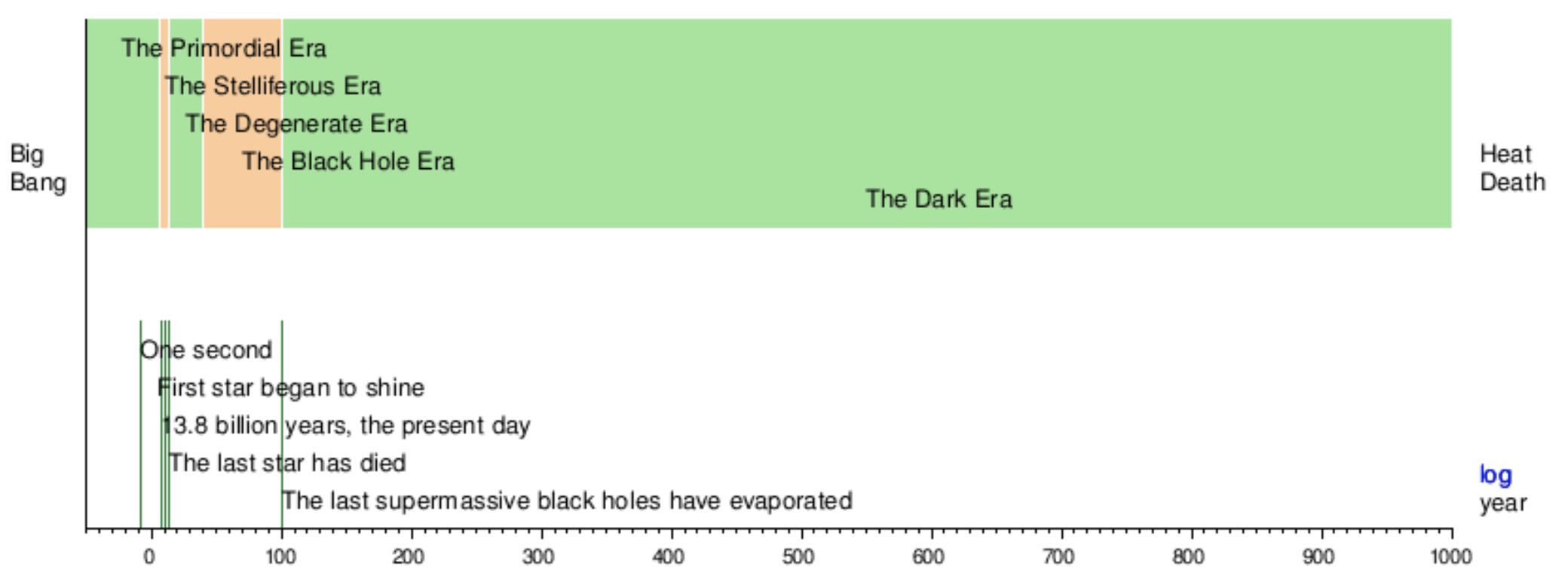Alright, this is kind of a Special Interest, so here's your relevant thought dump.
First up, the image is kind of misleading, in the sense that you can always tack on extra orders of magnitude. You could tack on another thousand orders of magnitude and make it look even longer, or just go "this is 900 OOM's of literally nothing happening, lets clip that off and focus on the interesting part"
Assuming proton decay is a thing (that free protons decay with a ridiculously long half-life)....
ok, I was planning on going "as a ludicrous upper bound, here's the number", but, uh, the completely ludicrous upper bound wound up being a WHOLE LOT longer than I thought. I... I didn't even think it was possible to stall till the evaporation of even a small black hole. But this calculation indicates that if you're aiming solely at living ludicrously long, you can stall about a googol years, enough for even the largest black holes to evaporate, and to get to the end of the black hole era. I'm gonna need to rethink some stuff.
EDIT: rethought some stuff, realized it doesn't change my conclusions from when I last looked into this. The fundamental problem is that, for any remotely realistic numbers, if you're trying to catch the final evaporation of a black hole to harvest its mass-energy, you'll blow a lot more than the amount of mass-energy that you could gain, in order to wait that long.
Final conclusion: If proton decay is a thing, it's definitely not worth waiting to the end of a black hole, you'll want to have things wrapped up far earlier. If proton decay isn't a thing, you'll want to wait till the black hole evaporates to catch that final party and last 1019 kg of mass-energy. If proton decay is a thing and you're willing to blow completely ridiculous cosmic amounts of resources on it, you can last till the late parts of the black hole era.
The rough rationale is as follows. Start with 10x the mass of the largest black holes in the universe, around 1012 solar masses stockpiled. If they're spinning fast enough, you can extract energy from them, assume you can extract all of it (it's over 10 percent, so let's round it up to 100 percent). Assume that proton decay is 1040 years (a high estimate), and that we use the energy at 100 percent efficiency to make matter (also high estimate), you can take out one proton, wait for around a proton decay time, take out the next proton, and so on. Then you can take out around 1069 protons, and each one lasts you around 1040 years, getting around 10109 years (high uncertainty). And, coincidentally, natural Hawing radiation finishes off the black hole of that size in 10103 years, leaving a small margin left over for silly considerations like "maybe the intelligence needs more than one proton to physically implement".
So, not remotely practical, but maybe something like 1080 years would actually be doable? That extra 29 OOM's of wiggle room patches over a lot of sins in this calculation.
But, in terms of what would actually be practical for the far future of humanity, it'd be the strat of "dump as much mass into a fast-spinning black hole as possible. Like, eat the entire Laniakea supercluster complex. Wait a trillion years for the cosmic microwave background radiation to cool to its floor temperature. You'd be in the late Stelliferous era at this point, with a few red dwarfs around, if you didn't dump all the stars in the mega-black-hole already. Set up some infrastructure around the mega-hole, and use the Blandford-Znajek mechanism to convert the mega-hole spin into electrical power. You should be able to get about a gigawatt of power for the next 1045 years to run a whole lotta computation and a little bit of maintanence, and if proton decay is messing with things, chop however many OOM's you need off the time and add those OOM's to the power output. Party for a trillion trillion trillion eons with your super-optimized low-temperature computing infrastructure"
